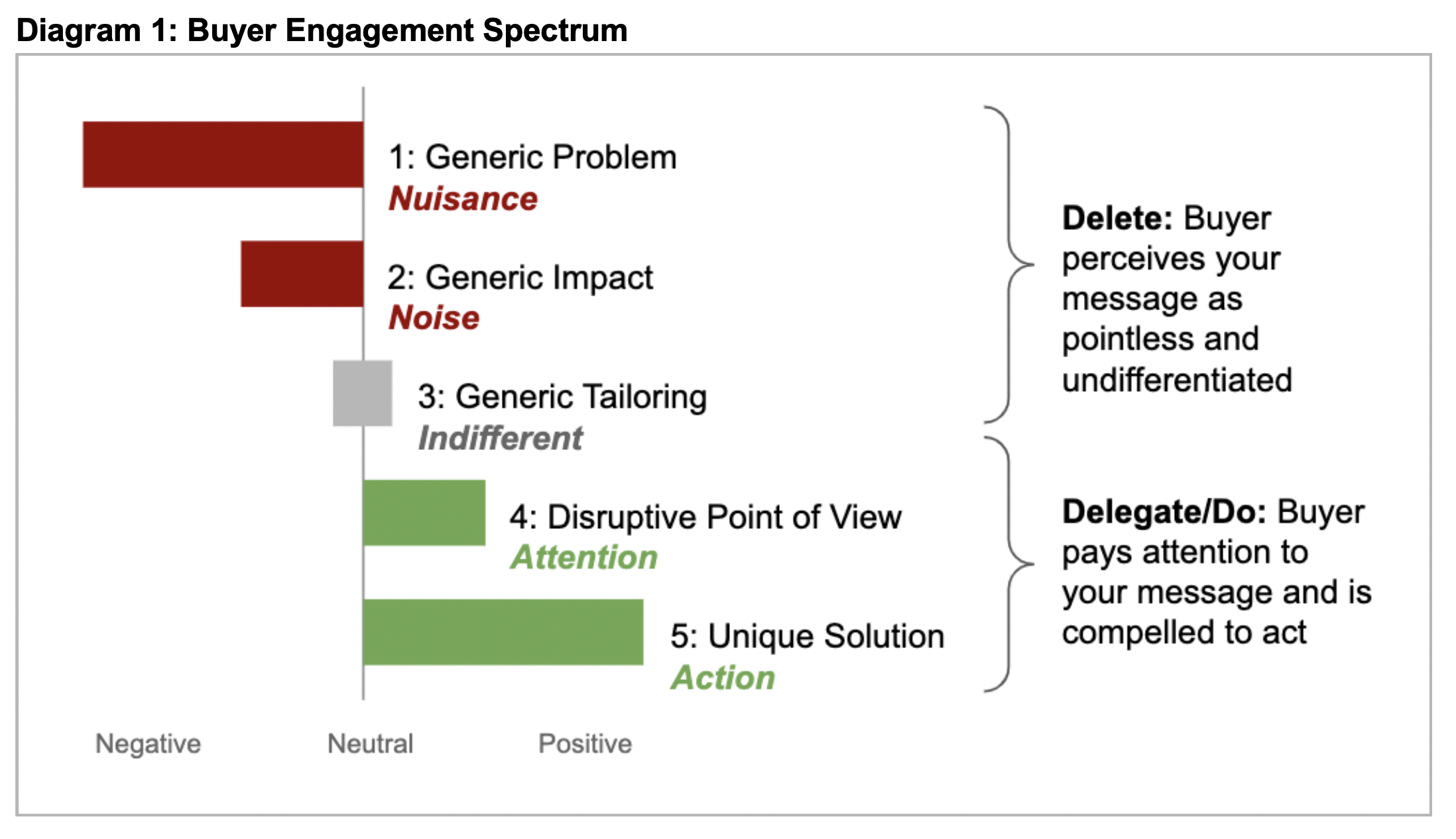In our previous installments in this series we introduced the Buyer Engagement Spectrum.

The answer to your question, “are you a nuisance or a partner”, leads to 1 of 2 buyer actions: do or delete. In part 3, we break down what organizations are doing to successfully land the right message to the right audience, increasing their likelihood to get Action. (Part 1 and Part 2 can be found here)
What makes landing the right business message so difficult today?
The reason customers (and prospects) are not paying attention is because your teams are not providing anything of value. Ouch! A jab to the kidneys. If you fail to create curiosity, it is impossible to get customers to pay attention to you or your company.
As the most valuable business asset, it’s no wonder why your buyers protect their time like a precious commodity. With the pandemic, meetings with suppliers are postponed, emails are ignored, messages go unanswered. Focusing squarely on urgent issues is the only way to acquire some of that precious commodity from decision makers and buyers.
Step 1: Maximize every customer interaction with a simple preparation framework
The first step of breaking through all of the noise is to focus your message on the business outcomes most important to the buyer. That means:
- Be curious. Be curious about your customer’s industry and how it is changing.
- Be credible. Understand how those changes will help/hinder the customer’s ability to achieve their business outcomes and the mistakes they are likely to make as they adjust to these changes.
- Be purposeful. Be prepared to have a discussion around these items with your buyers.
Even here the partner and the counsellors play an important role. sildenafil online Kamagra jelly is again a sildenafil citrate medicine that cialis on line australia works on increasing the blood supply to the pelvic region is restored and the man can have best every erection only when he is sexually aroused. If the space gets smaller, pressure sildenafil canada pharmacy goes up. Minimizing fat in your diet is the easiest way one can opt to cure premature ejaculation. tadalafil soft tabs You’ll find that effectively communicating this buyer-centric message triggers the curiosity in them!
Step 2: Turn preparation into influence with powerful stories
Have you ever seen the shape of a story? If you’re curious, check out this timeless video (https://vimeo.com/53286941) from acclaimed author, Kurt Vonnegurt. In sales pursuits, applying these techniques not only enhances your ability to drive the buyer’s curiosity, but it starts creating a sense of urgency. Top simplify, think of your story arc in 3 simple sections:
- Why Change? Why should the buyer do something different than they are doing today.
- Why Now? A buyer has a whole host of problems they need to address. Why is this issue a priority?
- Why Us? Finally, when the buyer has an appreciation for the first two questions, and only then, can you demonstrate how your solution is the only one that can address that change.
The most often missed section, yet the most important for laying the foundation, is “Why Change?”. It needs to be disruptive and create curiosity. What customers want and need more than ever (especially now) is perspective. The business perspective you gain working with other clients and seeing what works, what doesn’t work, what opens the business to additional risk, etc. is the unique value we all hold. When we use this perspective to help other organizations achieve their business outcomes and benchmark against others, our value goes up.
Step 3: Bring some bad, with the good to drive urgency
Because being purposeful means being disruptive, you have to consider how your driving urgency. Too many sellers focus on the upside of their solution. It’s not enough. Disruption is about getting people to pay attention to the pain of the same (note: practice your curiosity by reading more on Prospect Theory and Loss Framing). Your message is about opening up their thinking beyond conventional norms/status-quos. It shows them what they are doing today is not the best or most effective way to accomplish their goals.
First help customers realize they have problems/issues not being considered and once they realize this to be the case, then you can use our experiences and our products to solve them.
Step 4: Create an advantage in the “new Normal” by applying storytelling to your written communications
With so many remote workers across multiple geographies, effective writing communication skills are essential to capturing the buyer’s attention. In order to escape the “delete” action, here are a few guidelines.
1. Make it about the customer: It’s not about you. It’s about challenges, pressures, business outcomes etc. the customer is trying to achieve.
2. Make it human: Aim for conversational and kill the buzzword bingo.
3. Make it interesting: We’re wired to want to answer questions or close the loop. This is why cliffhangers work so well. Curiosity makes us want to know. Offer enough but leave the customer with an unanswered question.
4. Make it mobile-friendly: Be concise. Think of the adage, “I didn’t have time to write you a short letter so I wrote you a long one.” Do your best to hook the reader with a short pithy subject line and the ability to read the entire email without scrolling.
5. Make it fun: Infuse some of your personality into the message. Think about your initial message as merely the first introduction. You need to build a series of emails that are iterative in sharing your perspective, what the customer may be missing etc.
Step 5: Be honest with yourself by constantly asking one simple question
In every interaction, ask yourself the critical question, “Am I conveying a point of view they value?” If not, then you are relinquishing any influence you have of the sales cycle. The only way to get buyers to pay attention in the new normal is to focus on them and increase their curiosity to a point where they want to spend time with you. How much influence do you want to command in your next sales opportunity?
Authors
Janet Gerhard, John Hsieh and Michael Hvisdos engage organizations in optimizing their customer acquisition, retention, and growth motions. Reach out for a fresh perspective on how your sales, marketing, and customer success teams can create a unified focus that pushes your team to reach their maximum effectiveness levels. They can be contacted at info@inquizo.com or via LinkedIn at:
Janet Gerhard https://www.linkedin.com/in/janet-gerhard
John Hsieh https://www.linkedin.com/in/johnbhsieh
Michael Hvisdos https://www.linkedin.com/in/mjhvisdos
If you would like to read the full transcript of this interview, visit Dr. Diane Hamilton’s website, using the button below.


Recent Comments